There is a delusion that Azalea is a purely indoor plant. This is not so. Nature has created many varieties of garden azaleas, impressive beauty and variety of bright inflorescences. Motion paints of flowering shrubs will not leave a single person indifferent. Pink, white, orange, purple inflorescences densely "envelope" shrub of garden azaleas and bloom up to 2.5 months. How to grow such a shrub on the site yourself? What care is needed by this demanding culture? All features of the cultivation of azaleas are in this article.
Azalea in open soil, plant description
Azalea Sadovaya - a long-term beautiful shrub from the Merserek family. The plant is also often called "Rhododendron", which is absolutely not contrary to the botanical classification of this kind. On the contrary, the name "Azalea" is a collective toponym for many decorative species derived by breeders based on the genus Rhododendron. In the garden classification, azaleas and rhododendrons are still divided, taking into account the existing differences in the structures of the vegetative-generative plant organs.
- Countries such as China, North America and Japan are recognized as China, North America and Japan. Falling varieties of garden azaleas were cultivated in Russia since pre-revolutionary times, so at present many times of perennial are widespread in culture throughout the country, including in its cold regions.
- The height of the shrub may vary depending on the variety and reach a height of 50 cm to 3rd. Saving the plants are thin and elegant coated with smooth, light bark.
- Azalea leaves are not large, slightly elongated oval shape. Dense leaf plate pubescent. Root system surface.
- The greatest property of the shrub is its spectacular flowers, converting the plant in a bright, color, lush "cloud". Flowers massively dismissed on the tops of the shoots of last year and can be painted in pink, lilac, yellow, white tones, depending on the variety. Most often, the crown has a shape a little flatted funnel.

- The bloom of Azalea comes in spring (more often in April) and lasts almost until the middle of the summer. During flowering, the shrub is so thickly sealed with flowers, which sometimes because of the "flower extradition" is not even visible of the foliage of the plant. Similar spectacular splendor of blooming azaleas, which can last from 2 weeks to 2.5 months, allowed shrubs to take the honorable place among some of the best decorative plants intended for designing garden and park zones, household plots and other landscapes.
- The average life expectancy of the Azalea shrub is approximately 20-25 years.

Varieties and types of azaleas for open soil
Azalea is known to breeders already for a long time, so at present this type of plant has many varieties and varieties that differ in appearance, shrub height, flowering timing. Most of the varieties derived have increased frost resistance and grow perfectly even in the regions of risky agriculture.
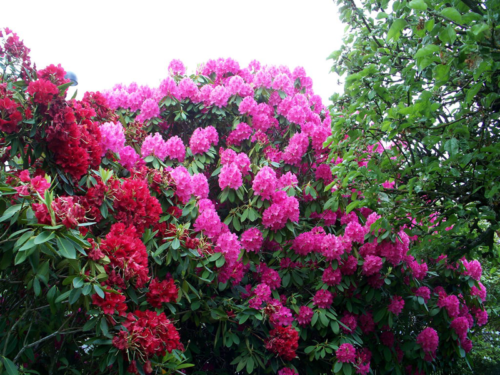
In Botanic, all garden azals are divided into 2 groups:
- Falls, i.e. Those that fall to the foliage fall.
- Evergreen, preserving the foliage (or its most of them) throughout the year.
The most popular among gardeners are large-flowered (deciduous) and Japanese types of garden azaleas.
- Large-flowered azaleas Posted by high empty shrubs with large flowers of different color and shape. The flowering of this group of azaleas begins at the end of spring and continues until June. The most common winter-hardy varieties are: "Freya", "Tunisia", "Chanel", "Stub", "Sonya", "Klondike", "Golden Sunset", "Golden Lights". Separate attention deserves a later-flowing variety of large-flowered azaleas with beautiful bright orange flowers, called Gibraltar.
- Japanese azalea They differ in slower growth rates, long (up to 2-2.5 months) a period of flowering and a neat, compact shape of a bush. In the height of Azalea this group, no more than 100 cm are growing. Dwarf molds are also cultivated, just 30 cm. Due to low-speed, compactness and pomp, the curtains of Japanese azaleas are often used as a spectacular soil plant. The colors of the varieties of Japanese azaleas are also varied: from gently purple to a saturated purple shade. Such varieties are recognized as the most popular Japanese garden azals: "Kermezina", "Silvester", "George Leases", "Blue Danube", "Rosinetta", "Marushka", "Rubinshtern", "Petticoat", "LedikaNense". The "Petticoat" grade grows no higher than 50 cm and blooms late in autumn, gentle pink flower. But Azalea "Ledikanense" blooms on the contrary, early (in spring), abundantly covering a bush with a purple tint inflorescences. Azalea White "Adonis" is characterized by snow-white inflorescences and glossy, olive leaf leaves.

Where to buy Azalia for open soil?
Azalea flower is a fairly widespread plant grown in the garden. Therefore, it is not difficult to buy perennial seedlings. This can be done in any specialized store or nursery. Better, if the selected Azalea instance is zoned, i.e. Adapted to local climatic conditions.
- Shrub seedlings should be purchased in the spring, immediately before landing them into the open ground. The best age for planting young seedlings is considered 2-4 years.
- The best option is to buy azalea seedlings with a closed root system, in wide pots with fertile soil. According to the reviews of the gardeners grown by Azalia, the seedloves transplanted from the pot easily and quickly rooted in a new place.
- Outwardly, a young azalea seedling should look healthy, without damage and dry shoots. The soil in the container must be wet. And in the case of buying seedlings with an open root system, the roots should also be moistened with a lore land.
Landing azalea in open soil
"Beauty" Azalia is considered a fairly demanding culture, so it is important for it initially choose the place of landing and observe all the necessary agrotechnical conditions.
In case of successful rooting, under favorable care conditions, Azalea will bloom in the garden in 3-4 years.

Location and time of landing azalea in open ground
When choosing a place to plant azalea seedling, it is important to remember that culture this long-term and slowly growing, and therefore it should be responsible to approach all stages of its landing and further cultivation.
- Light-loving azalea prefers an open sunny terrain. At the same time, the ingress of direct sunlight adversely affects the decorativeness of the shrub: the number of flower kidney decreases, flowering time is reduced. In this regard, for a garden azalea, it is necessary to choose a level, protected from open winds a plot located in lightweight, openwork. It is in such conditions that the perennial retains the maximum decorativeness and will not suffer from cold wind, winter jellows and summer heat. A thick shadow, as well as the scorching sun, is not suitable for many years of culture. In the shadow of Azalya ceases flowering and cares.
- For landing azalea should not choose lowlandssubject to frequent flood after melting snow. But the location near any reservoir will be very useful. Such natural wetting of the shrub will allow him to preserve the freshness of the green mass longer and increase flowering time.
- Azalea feels great in the garden in the company of large trees. The main condition is the roots of the plants - the "neighbors" did not interfere with each other. The ideal "companions" will be trees with a rod root system, such as linden, spruce, oaks, etc.
- Optimally favorable period for planting or transplanting azaleas in open ground is early spring, Before the start of active sap flow of plants. Autumn planting time is possible only in exceptional cases, as great a risk of freezing in winter seedling. If it still intended to land fall, the procedure should be carried out in September, so that the bush had to adapt and acclimatize to the new location before the cold weather. In winter, these same plants will need to be carefully insulated.
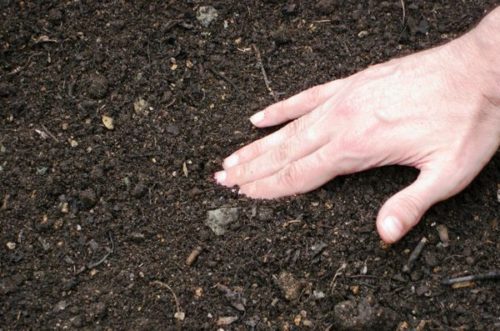
Agrotechnics planting in open ground azalea
- Before planting it is important to prepare the site: dig and fertilize the ground. Primer for planting azaleas should include: turf (or coniferous) ground, peat, sand, humus. Such a mixture can be done by yourself or buy in the store. The best soil mix for seedlings will be loose, fertile and structured substrate with good breathability.
- Given that the azalea has a shallow root system, preparing the landing pit is not deep for perennials, but wide. Thus, it will be sufficient depth of half a meter, but the width should exceed a depth of about 30 cm. At the bottom of the pit is placed a drainage layer of broken bricks, sand, gravel or expanded clay. In no case can not be used as a drainage limestone chips as lime gradually affect the acidity of the soil, which may lead to death of plants. Garden azalea preferred soil with high acidity (pH 4 - 4.5).
- The planting hole prepared directly on the drainage layer, poured (slide down the middle) part of the soil mix, and where expose seedling. plant roots gently straighten and covered with the remaining mixture. In this case the root collar azaleas should remain above ground level.
- After planting, the soil is compacted, the plant is watered. It is best to immediately zamulchirovat tree trunks bush. As the mulch is ideal for pine bark, which, in addition to its core functions, will also maintain the desired acidity of the soil.
- When buying azalea seedlings with an open root system, a plant before planting is left in water for several hours so that the roots can absorb moisture and restore the tour. The seedlings sold in the container do not need such a procedure, and during the transplantation of azalea, the gardeners try to fully preserve the earthen coma of the young plant. Another advantage of buying container seedlings is a wide range of time for landing them: starting from April and ending in October.
- When landing, it is important not to damage the roots of the Azalea plant, on which useful mycorrine is present. Such "fungocorn" improves the absorption of nutrients and increases the overall life of the culture.
- Slowing down on the site several varieties of azaleas, it is important to know the alleged dimensions of adult shrubs. Depending on this, they determine the distance between the plants during the landing. On average, the interval between the overall copies of Azalea leaves about 1 - 1.5 meters, and there will be half a meter between small varieties.
Azalea, Features of care in the open ground
How to properly care for Azalia, so that the garden beauty pleases the surrounding many years? Consider the main agrotechnical activities of the cultivation of shrub in the open soil.
Watering, loosening and mulching azalea
- By nature, Azalia is considered moisture plants, and therefore, watering in the process of growing shrubs plays one of the key roles. From moisture directly will depend on the decorativeness of the perennial, the abundance and duration of flowering. From drought, the shrub shrub turns and "chash".
- Purify the azalia is abundant and regularly, as the surface layer of the soil is drying. Watering is not under root, and at some distance (20-25 cm) from the trunk.
- The best water for watering garden azaleas will be rain or resistant for several days. Soft water. The best time for watering is morning or evening.
- Given the predisposition of azaleas to the acidic medium, once a month the culture is watered with acidic water that contributes to an increase in the acidity of the soil. To do this, citric acid is added to the water.
- In dry days (in addition to the period of bootonization and flowering), the shrub is sprayed with water. Such "water procedures" maintain the decorativeness of the plant and protect against insect pests.
- By the end of the summer, watering is reduced, gradually preparing Azalea shrub to the upcoming wintering.
- Excellent results of preserving a wet microclimate and weed control gives such a reception as mulching. In addition, the mulch prevents the root system from freezing in winter. For the mulching layer, any material is suitable: needles, chips, sawdust, beveled grass, fine ceramzite. Do not close the mulch root shrub and forget about the periodic update of the mulch layer.

Support and fertilizer azalea
- So that Azalia pleased the surrounding lush and abundant blossoms, the shrub needs regular feeding. Throughout the growing season, the perennial fertilize three times.
- In the event that Azalea was planted from the container where the fertilizer of prolonged action was present, it is not necessary to feed the garden culture over the next year. The feeder should be administered only from the 2nd year of the life of the shrub in the open soil.
- The first organic feeding is carried out early in spring. For this, culture is watered with a cowboy or humoring.
- The second feeder is carried out during the bootonization period, before the start of flowering. The rational one in this period use complex mineral fertilizers with nitrogen, phosphorus and potassium content.
- The third feeder is carried out after withering. The azalia is watered with a solution of phosphorus-potash fertilizers with a predominance of potassium (1: 2).
- It is not worth using fertilizers containing chlorine or lime as a feeding of azalea, as it will negatively affect the acidity level of the soil. Not suitable for many years of culture and wood ash.
- Supporting the plants are usually combined with irrigation and conduct it in the same way as watering, to the area of \u200b\u200bthe priority circle (not under the root). This technique allows you to "deliver" nutrients to the entire surface root system of the shrub.
Pruning azalea
- Like most other decorative shrubs, Azalea needs pruning. Pruning begin to spend after 3 years of life of the shrub.
- In the spring, after wintering, they conduct a sanitary crop. At the same time remove all dry, patients or damaged branches.
- Forming trimming is carried out after the fading of all colors of azaleas. During this period, too long shoots and dry decays of azaleas are cut. Such trimming is engraving a shrub, prevents uncontrolled overgrowth and thickening.
- Considering that future buds are formed in annual shoots, with a "haircut" bush, the increase in the current year does not touch.
- Places of sections of major shoots are treated with garden ward.

Fighting pests and diseases of azalea
- For the most part, all varieties of azaleas are highly resistant to diseases and pests.
- But, sometimes, due to the unfavorable conditions of the environment or improper care, garden azalea can face some problems.
- If atypical shine and individual plaques appeared on the leaves of many years of culture, - on the plant "attacked" the shields. To combat insects, they are removed by hand, and the bush is treated with soap solution. If after collecting and spraying the pests did not disappear, the use of insecticide will take.
- On Azalea, a web tick can also start, which emanates the leaves and shoots thin cobwebs. This pest causes irreparable harm to the shrub, sucking the life juices from it, so the plant immediately needs to be treated with an insecticidal drug.
- Another pest characteristic of all Azali is a torment Cherver. The first sign of the presence of an insect on the bush is the change in the shape of the leaves. To combat Cherver, the plant is treated with soap solution, and if the destruction zone is too large - they resort to the help of chemicals.
- When the moisture is re-published, the development of fungal diseases is possible: spottedness (brown spots), rot, mildew, rust, phytoofluorosis. To combat diseases use a variety of fungicidal preparations.
Preparation of azalea by winter
- Most of the modern varieties of azaleas are pretty frost-resistant plants, feel frozen in the limits of -25-30 0WITH.
- In regions with a moderate climate, Azalea winter freely without covering, but in the zone of harsh cold and low-snow winters you will need "insulation" of shrub. After all, if the azalea bushes (especially its floral kidneys) will suffer in winter, it will affect their development and flowering in the warm season.
- To protect the root Azalea's root system, it is important to provide a plant a number of events, starting with abundant irrigation in the fall and ending with the preparation of the additional layer of mulch (10-30 cm).
- Separate attention will be required branches of shrub. There are several ways to insulate the crown of azalea:
- to lean branches to the ground and fix them with wire, after which it is possible to close with any insulation (cardboard, agrofiber, sweetheart or sprinkle peat). Use airtight materials in this business is extremely undesirable, since the risks of the development of rot or hearing the kidneys;
- leave branches in a vertical position, slightly twist them (not tight) and construct the frame. From above, this design is covered with rubberoid or other nonwoven material.
- All work on the insulation of the shrub is carried out with the onset of cold weather to avoid the death of the shrub flower kidney.
- In minor winter it will require additional collection of snow to the base of the shrub.
- Removal of shelter is carried out in spring, after melting of snow and establish a steadily positive air temperature.

Azalea reproduction
Azalia is best breeding in a vegetative way: cuttings or chains.
- The hauling is carried out in spring (in March-April months). For this (at an angle of 45 0) The top cuttings are cut off with a sharp knife (with young shoots), about 10 cm long. Top kidney and lower leaves are removed on cut shoots, leaving only 3-4 well-developed sheets. Azali's cuttings are immersed in the root growth stimulant ("Epin", "Korniner", etc.), after which it is planted in containers with a prepared soil-peat substrate. It is important that in the container there were enough holes for draining excess water. Individual plastic cups with holes made at thenime or peat glasses are also suitable. The cuttings deepen into the ground to a depth of 3-4 cm, spray with water from the spray and covered with a can be covered with a can be with a can with a can with a can with a can. The main cargo care is reduced to watering, ventilating and maintaining the optimal favorable temperature (18-20 0WITH). After about 1.5 months, the cuttings should be rooted. In the case of successful rooting, the seedlings are transplanted into open ground.


2. This method of reproduction is suitable for adults of low azalea bushes with elongated side shoots. These side shoots and will serve as a brass. Spring tilge and "pinch" to the ground using a metal bracket. For convenience, a shallow trench is preparing for convenience, where the escape is stacked. Escape is sprinkled with soil and provide regular watering. At the following spring, a successfully rooted escape is separated from the mother's bush and disembark separately.
3. The seed method of reproduction is low-productive, long (it is necessary about 8 years to first flowering) and laborious, therefore it is rarely used by floweries. Azalese seeds are seeded in a sour nutrient soil, covered with glass, moisturized and ventilated "mini greenhouse." The grown seedlings are peeling into separate containers and fuse in the warm room for another 1-2 years. After that, the seedlings plant in open ground, providing proper care and mandatory "winter shelter".
Problems in the care of garden azaleas
In the process of growing azaleas, some problems may arise, from the successful solution of which will depend not only by the decorative type of plant, but also its life. Consider how to save Azalia in one way or another.
- Azalea does not bloom.
The following factors can be the reason for the lack of blossom of shrubs: lack of lighting or moisture, an oversupply of nitrogen-containing fertilizers, freezing of generative (floral) kidneys, the appearance of pests or diseases, air temperature Over 25 0C, alkaline type of soil.
- Azalea is popped.
If the shrubs fall out of the leaves, it may have a soil not enough with a sour Wednesday. The plant responds negatively to the snap-made soil.
- Azalea dries.
Drying the shrub can be associated with a lack of moisture, not sufficiently sour soil or too open, for scoring sunlight, location.
- Azalea turns yellow.
Unnecessaryly yellowed and decreasing the leaves of Azalea's leaves indicate a lack of nitrogen or potassium. When lacking the last element (potassium), the leaves are yellowing along the edges, spinning up. Phosphorus deficiency provokes a darkening of the azalea sheet plate and the appearance of brown spots in the center of the central resolution.
Application Azalea in Garden Design
- Garden Azalea is a wonderful decorative "material" in the hands of not only professional landscape designers, but also simple amateurs of flower water. After all, the usual landed rustling bush will become a real decoration of any garden or a household plot.
- Azalea looks effectively both in a single landing, as a bright accent, and in picturesque group plantings.

- Garden azaleas look well against the background of any coniferous cultures, as well as in the company with Camellia, Version, Barbaris, Hortensia and Weigel.
- Pictures will look like group landing azaleas of different colors. At the same time, high shrubs should be located in the center, and the lowered around the perimeter. Mix leaf fall and evergreen varieties in the same group is not recommended, since in the spring and autumn, the decorativeness of the plantings will suffer greatly.

Thus, garden azalea, without exaggeration, is a real favorite among many decorative perennials. Enjoying the beauty and splendor of her blooming shrubs, it is important to remember the demanding of this garden culture to cultivation conditions. Only observing all the rules of agricultural engineering and the care of the perennial, you can grow a "miracle shrub" on its plot.

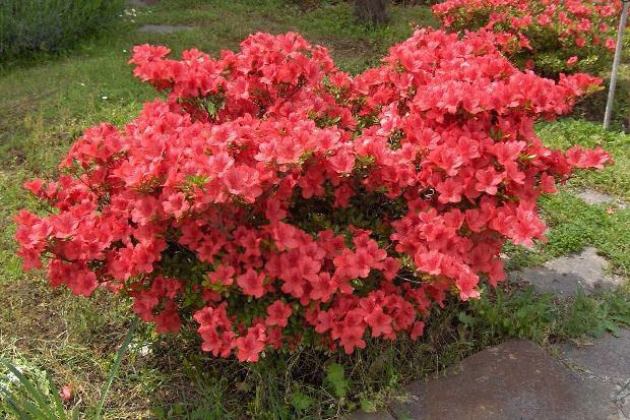


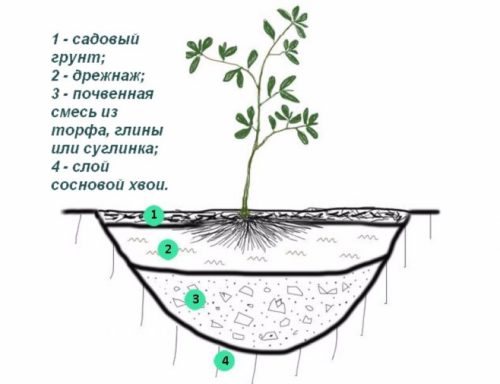

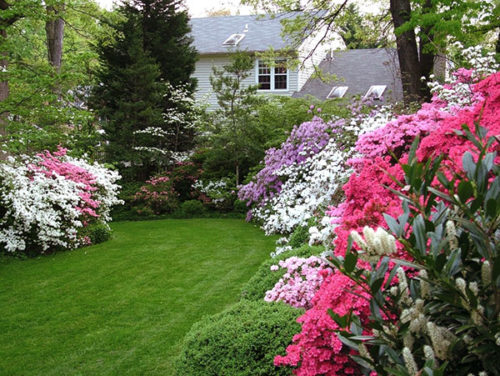

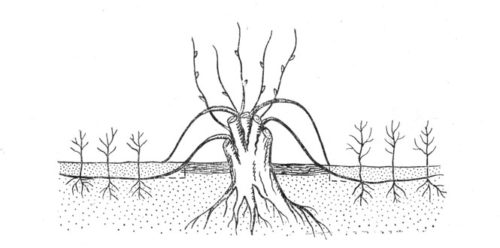
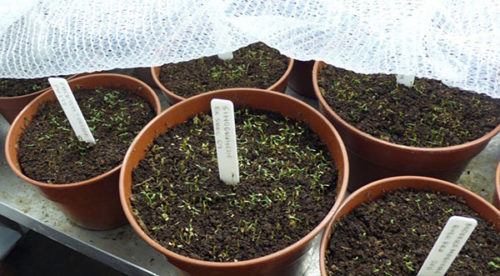

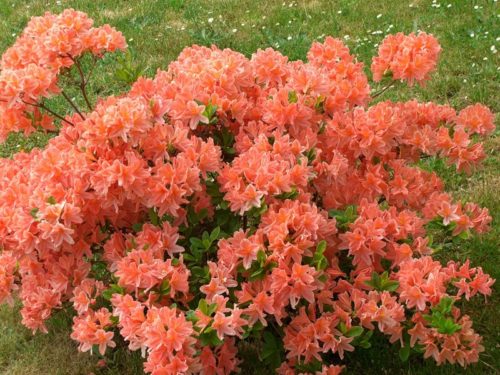
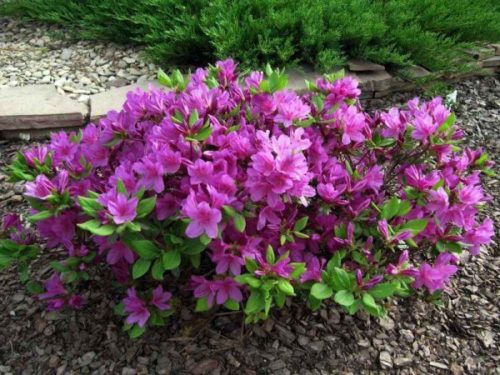
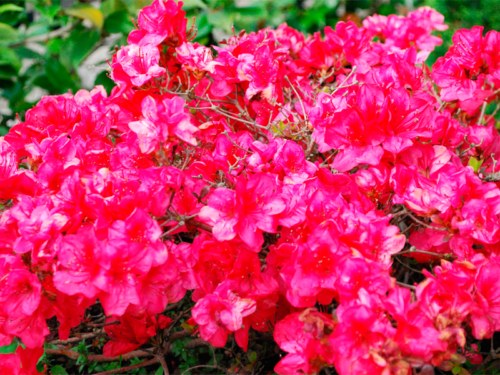
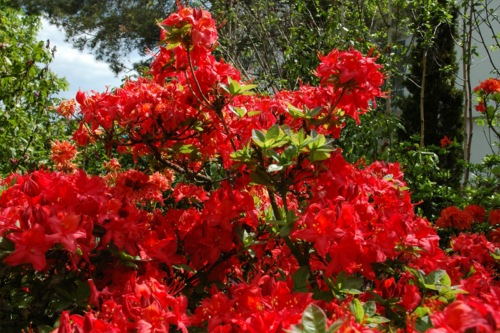


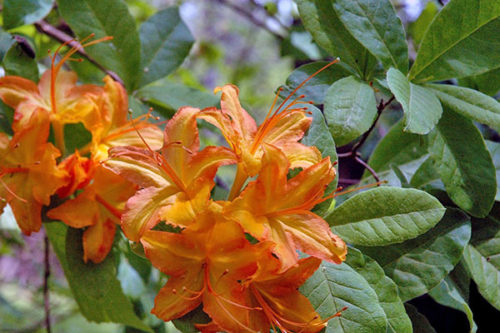
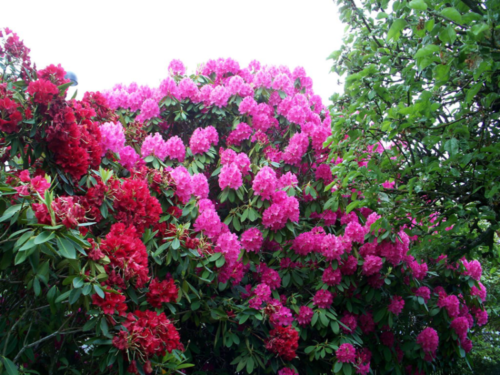
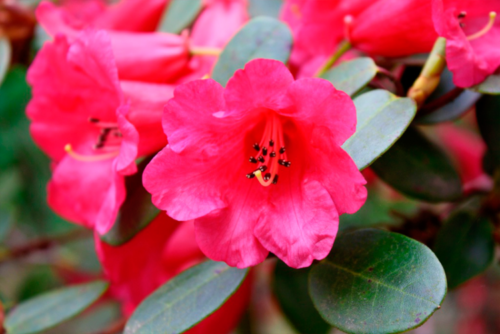
















 Start a discussion ...
Start a discussion ...